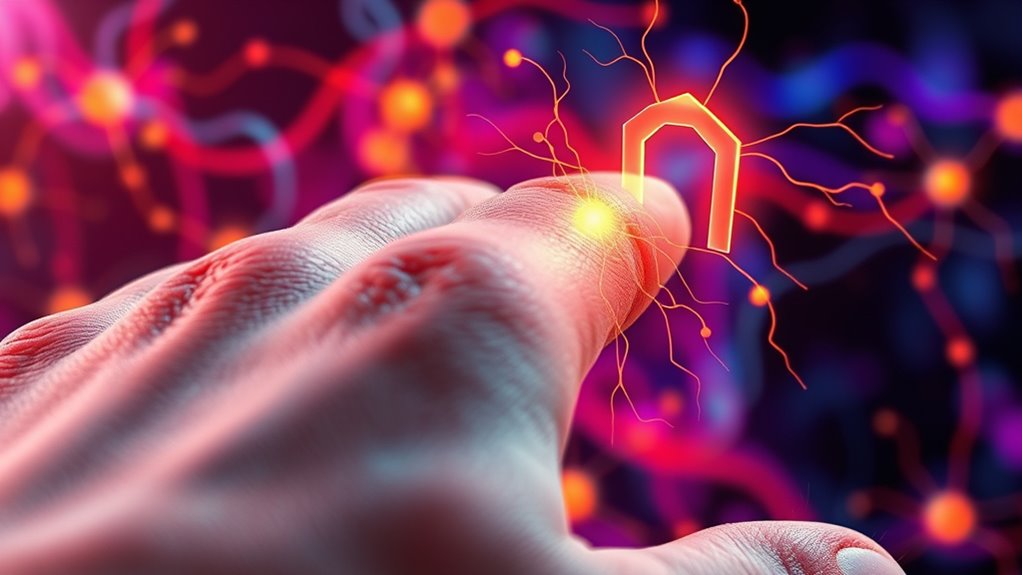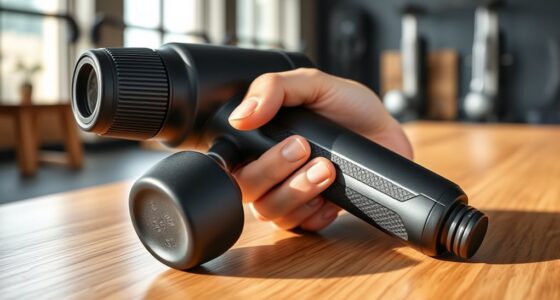Central pain modulation is how your nervous system actively controls pain signals before you become aware of them. The gate control theory explains that a “gate” in your spinal cord opens or closes based on factors like attention, emotion, and past experiences. When closed, it reduces or blocks pain, making it feel less intense or disappear. If you’re curious about how these mechanisms work to influence your pain, there’s more to discover.
Key Takeaways
- Central pain modulation involves brain and spinal cord processes that regulate how pain signals are perceived and responded to.
- The Gate Control Theory proposes a “gate” in the spinal cord that controls pain signal transmission to the brain.
- The gate opens or closes based on psychological factors, attention, and past experiences, affecting pain intensity.
- Neuroplasticity allows the nervous system to rewire, enabling strategies to strengthen pain-inhibiting pathways.
- Psychological and physical techniques can activate descending pathways, helping to reduce or block pain signals.

Central pain modulation refers to the brain and spinal cord processes that regulate how we perceive and respond to pain. This system isn’t just a passive pathway; it actively influences whether pain feels intense, mild, or even disappears altogether. Recent neuroplasticity research has shed light on how adaptable these processes are, revealing that your nervous system can change and rewire itself in response to various stimuli. This understanding is vital because it opens the door to new pain management strategies that target the central nervous system directly, rather than relying solely on medications.
Central pain modulation involves brain and spinal processes that actively regulate pain perception and response.
When you experience pain, signals travel from the site of injury or damage through peripheral nerves to the spinal cord and then up to the brain. But central pain modulation can amplify, diminish, or even block these signals before you consciously perceive pain. The gate control theory, a foundational concept in understanding this process, suggests that a sort of “gate” in the spinal cord can open or close depending on various factors, such as psychological state, attention, or prior experiences. Think of this gate as a filter that decides which pain signals get through to your brain and which don’t. If the gate is closed, pain feels less intense or disappears; if it’s open, pain becomes more prominent.
Your brain’s ability to modulate pain isn’t fixed—it’s highly adaptable. Neuroplasticity research demonstrates that through certain pain management strategies, like cognitive-behavioral therapy, mindfulness, or physical therapy, you can influence this gate to reduce pain perception. These strategies work by strengthening the brain’s capacity to inhibit pain signals or by reconditioning neural pathways involved in pain processing. For example, learning to focus your attention away from pain or developing relaxation techniques can activate descending pathways that suppress pain signals at the spinal level. Additionally, understanding central pain modulation helps explain why psychological factors can significantly impact pain perception.
This dynamic system means that pain isn’t just a direct consequence of tissue damage but also shaped by your mental and emotional states. Understanding central pain modulation emphasizes the importance of holistic approaches to pain management, combining psychological and physical strategies to harness your nervous system’s plasticity. By doing so, you can potentially reduce chronic pain, improve your quality of life, and regain control over your pain experience. Fundamentally, your brain and spinal cord are powerful tools that, with the right techniques, can be trained to lessen pain and enhance your overall well-being.
Frequently Asked Questions
How Does Central Pain Modulation Differ From Peripheral Pain Control?
Central pain modulation differs from peripheral pain control because it involves neuroplasticity mechanisms in your brain and spinal cord that adjust how you perceive pain. You experience pain perception variability based on these central processes, which can amplify or diminish signals. Unlike peripheral control, which targets nerves outside your central nervous system, central modulation actively shapes your pain experience, making it more adaptable to your overall health, emotions, and context.
Can Central Pain Modulation Be Influenced by Psychological Factors?
Yes, you can influence central pain modulation through psychological factors. Your psychological impact, such as stress or anxiety, can alter how your brain processes pain signals. Emotional regulation techniques like relaxation, mindfulness, or cognitive-behavioral therapy help you manage these influences. By actively working on your emotional state, you can enhance your body’s natural pain control mechanisms, reducing pain perception and improving overall comfort.
What Role Do Neurotransmitters Play in Pain Modulation?
Neurotransmitters play a vital role in pain modulation through signaling across synapses. You influence this process by affecting neurotransmitter release, which can either amplify or inhibit pain signals. Additionally, synaptic plasticity allows these signals to adapt over time, strengthening or weakening pathways based on experience. By understanding and targeting neurotransmitter signaling, you can potentially alter pain perception, making treatments more effective for managing chronic pain.
Are There Specific Disorders Associated With Dysfunctional Pain Modulation?
Did you know that around 20% of chronic pain cases involve dysfunctional pain modulation? You might experience this if you have neuropathic conditions or fibromyalgia, where your body’s ability to regulate pain is impaired. These disorders can cause your pain signals to become amplified or misinterpreted, leading to persistent discomfort. Recognizing this dysfunction helps in tailoring effective treatments and managing symptoms better.
How Can Therapies Target Central Pain Modulation Pathways Effectively?
You can target central pain modulation pathways effectively by leveraging neuroplasticity mechanisms through specialized pain pathway interventions. These therapies, such as cognitive-behavioral therapy, physical therapy, or neuromodulation, stimulate the brain’s ability to rewire and adapt, reducing pain perception. By actively engaging in these interventions, you help strengthen inhibitory pathways and diminish the influence of pain signals, leading to improved pain management and overall well-being.
Conclusion
Just as a skilled maestro directs an orchestra, your brain fine-tunes pain signals through central pain modulation. The gate control theory acts like a vigilant gatekeeper, deciding which signals pass and which are kept at bay. Remember, you hold the baton in managing your pain—learning how your nervous system works empowers you to take control, much like a hero charting their own story. Embrace this knowledge, and you can master the symphony of your body’s responses.









